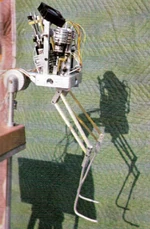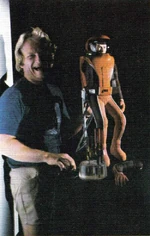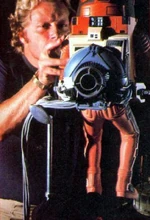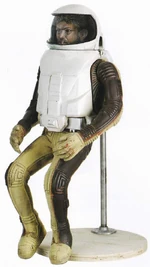m (frm.) |
m (→Design: lnk.fx.) |
||
| (25 intermediate revisions by 2 users not shown) | |||
| Line 1: | Line 1: | ||
{{realworld}} |
{{realworld}} |
||
[[File:Thruster suit (detached).jpg|thumb|Spock detaching the thruster pack from his suit]] |
[[File:Thruster suit (detached).jpg|thumb|Spock detaching the thruster pack from his suit]] |
||
| − | The '''thruster suit''' was envisioned as a variation of an '''[[environmental suit]]''', that could be equipped with a detachable [[thruster]] pack for use to travel short distances, and has been seen in use in {{film|1}} by, among others, Starfleet personnel at the [[Epsilon IX station]] as well as the [[Earth_spacedocks#USS_Enterprise_spacedock|drydock]] were the upgraded {{USS|Enterprise|NCC-1701}} was refurbished. Equipped with the thruster pack, [[Spock]] utilized such a suit |
+ | The '''thruster suit''' was envisioned as a variation of an '''[[environmental suit]]''', that could be equipped with a detachable [[thruster]] pack for use to travel short distances, and has been seen in use in {{film|1}} by, among others, Starfleet personnel at the [[Epsilon IX station]] as well as the [[Earth_spacedocks#USS_Enterprise_spacedock|drydock]] were the upgraded {{USS|Enterprise|NCC-1701}} was refurbished. Equipped with the thruster pack, [[Spock]] utilized such a suit when entering and exploring the ''[[V'Ger]]'' entity in the early [[2270s]], whereas [[James T. Kirk]] subsequently used a thruster suit to retrieve Spock. The design of the suit was re-utilized in {{film|2}}. Though full-scale suits were manufactured for the actors to interact with in ''The Motion Picture'', they themselves soldiering on in ''The Wrath of Khan'', the construction of a [[studio model|miniature]] was deemed necessary for ''The Motion Picture''. |
| + | {{clear}} |
||
| − | |||
==Design== |
==Design== |
||
| ⚫ | |||
[[File:Truster suit as designed by Andrew Probert.jpg|thumb|left||Probert's preliminary take on the EV suit]] |
[[File:Truster suit as designed by Andrew Probert.jpg|thumb|left||Probert's preliminary take on the EV suit]] |
||
| + | {| class="wiki-sidebar" style="float:right;" |
||
| ⚫ | An [[extravehicular activity]] |
||
| + | |- |
||
| + | | colspan="1" align="center" |[[File:Truster suit design.jpg|150px]] |
||
| + | | colspan="1" align="center" |[[File:Truster suit truster unit design.jpg|150px]] |
||
| + | |- |
||
| ⚫ | |||
| + | | class="even" | <center>Johnson's thruster pack designs</center> |
||
| + | |} |
||
| ⚫ | An [[extravehicular activity]] had already been envisioned in a final draft of the "[[In Thy Image]]" pilot episode of the ''[[Star Trek: Phase II]]'' television project. After ''Phase II'' was upgraded to a major movie production in November 1977, it was [[Paramount Pictures]] themselves who started with the design and partial construction of a full scale suit, which was reminiscent of the [[Environmental suit#EV suit 2|one]] seen in ''[[Star Trek: The Original Series]]''. Deemed unsuitable, notoriously nearly suffocating Spock performer [[Leonard Nimoy]], [[Brick Price Movie Miniatures]] took over the re-design work for the suit in the summer of 1978. (''Enterprise Incidents; special edition on the technical side'', pp. 38-42) In the autumn of 1978 the design work was handed over to Production Illustrator [[Andrew Probert]] of [[Astra Image Corporation]], the art department subsidiary of [[Robert Abel & Associates]] (RA&A) who were to produce the visual effects for the ''Motion Picture'', who submitted some preliminary designs for the environmental suit in October 1978. Unfortunately for him, due to the [[Star Trek: The Motion Picture#Visual effects|visual effects debacle]], RA&A was pulled from the project on 22 February 1979. Succeeded by [[Douglas Trumbull]]'s [[Future General Corporation]], it was decided to fine tune the spacesuit design at [[John Dykstra]]'s [[Apogee, Inc.]], when that company was brought in to ease the workload, since a first appearance of the suit was envisioned in a sequence Apogee was responsible for, to wit, the [[Epsilon IX station]] footage. |
||
| ⚫ | At Apogee, Production Illustrator [[Jack Johnson]] took over the task of designing the suit as well as that of the [[thruster]] pack that could be optionally attached to it. Details on the suit were designed by Animation and Graphics Artist [[Greg Wilzbach]]. It was their envisioned versions that were predominantly featured in ''The Motion Picture''. Johnson was also the one who designed the thruster pack unit. (''[[The Art of Star Trek]]'', pp. 180-181) |
||
| ⚫ | |||
| ⚫ | At Apogee, Production Illustrator [[Jack Johnson]] took over the task of designing the suit as well as that of the [[thruster]] pack that could be optionally attached to it. Details on the suit were designed by Animation and Graphics Artist [[Greg Wilzbach]]. It |
||
| − | Andrew Probert |
+ | Andrew Probert sold off his preliminary designs as [http://www.liveauctioneers.com/item/11168285_star-trek-environmental-suit-concept-artwork Lot 76] in the [[Star_Trek_auctions#Propworx.2C_Inc.|Propworx, Inc.]]'s ''[[Star Trek auctions#STAR TREK auction III|STAR TREK auction III]]'' of 24 March 2012 for US$150, having had an estimate of US$100–$200. [http://www.startrekpropauthority.com/2012/03/propworx-star-trek-auction-iii-march-24.html] |
==Studio model== |
==Studio model== |
||
[[File:Thruster suit model sculpted by Apogee's David Sosalla.jpg|thumb|Sosalla working on the heads for the model]] |
[[File:Thruster suit model sculpted by Apogee's David Sosalla.jpg|thumb|Sosalla working on the heads for the model]] |
||
| − | Apart from having full scale suits made for the actors to interact with, a scaled [[studio model|miniature]] was deemed necessary for the long shots. |
+ | Apart from having full scale suits made for the actors to interact with, a scaled [[studio model|miniature]] was deemed necessary for the long shots. That miniature was also constructed at Apogee, and Dykstra has elaborated, |
| − | <blockquote>"Another thing we did for the Epsilon 9 sequence was build a two-foot tall scale model spaceman that we had zipping around this way and that. [[Douglas Trumbull|Doug]] used it also in the drydock sequence and in the Spock spacewalk. [[David Sosalla]] did the sculpting, including the faces of Spock and the others who would be inside the suit; and [[John Ramsay]] worked out the mechanics for articulating the arms and legs. It was shot using motion control, and then we went back in with animation and added little blips of energy from the thrusters. |
+ | <blockquote>"Another thing we did for the Epsilon 9 sequence was build a two-foot tall scale model spaceman that we had zipping around this way and that. [[Douglas Trumbull|Doug]] used it also in the drydock sequence and in the Spock spacewalk. [[David Sosalla]] did the sculpting, including the faces of Spock and the others who would be inside the suit; and [[John Ramsay]] worked out the mechanics for articulating the arms and legs. It was shot using motion control, and then we went back in with animation and added little blips of energy from the thrusters. |
| − | "There were a couple nice shots that didn't get into the film, where the puppets are being chased by the destruction in a different way than we've got them appearing now. But we ran out of time, and weren't able to get them to go together right."</blockquote> |
+ | "There were a couple nice shots that didn't get into the film, where the puppets are being chased by the destruction in a different way than we've got them appearing now. But we ran out of time, and weren't able to get them to go together right." (''[[Cinefex]]'', issue 2, pp. 58-59)</blockquote> |
{| class="wiki-sidebar" style="width:100%;" |
{| class="wiki-sidebar" style="width:100%;" |
||
|- |
|- |
||
| Line 31: | Line 37: | ||
| class="even" | <center>As the Kirk miniature at auction</center> |
| class="even" | <center>As the Kirk miniature at auction</center> |
||
|} |
|} |
||
| + | [[File:Thruster suit miniature about to be digitized by V'Ger.jpg|thumb|left|The orange painted model about to be digitized by V'Ger]] |
||
| ⚫ | |||
| + | [[File:Thruster suit model Spock head sculpture.jpg|thumb|One of Sosalla's Spock head sculptures]] |
||
| ⚫ | |||
| ⚫ | For their appearances, Sosalla sculpted several 3½ inch heads out of resin for representation of whomever was supposed to be in the suit. The models themselves were equipped with servo motors and electronics for articulation. One of Sosalla's sculptures of Spock's head later turned up at Profile in History's ''[[Star Trek auctions#Hollywood Auction 43|Hollywood Auction 43]]'' of 18 December 2010 as Lot 1000, were it was sold, having had an estimate of US$1,000-$1,500. |
||
Painted with orange highlights, the miniature was first used to shoot the sequences of the unfortunate Starfleet member caught in the digitizing of the Epsilon IX station and Spock's spacewalk in V'Ger. Subsequently, the highlights were repainted brown/beige for the sequences in the drydock and Kirk's EV scenes. |
Painted with orange highlights, the miniature was first used to shoot the sequences of the unfortunate Starfleet member caught in the digitizing of the Epsilon IX station and Spock's spacewalk in V'Ger. Subsequently, the highlights were repainted brown/beige for the sequences in the drydock and Kirk's EV scenes. |
||
| ⚫ | |||
| ⚫ | |||
| ⚫ | |||
| − | After |
+ | After its use in ''The Search for Spock'', the miniature was stored away on the [[Paramount Pictures]] lot and largely forgotten about, until Probert and [[Rick Sternbach]] rediscovered it. As the latter remembered, "''If I recall correctly, when Andy was painting the head to look like himself, the rest of the suit hardshell was the orange color (early 1987?). I think we found the thing in a box in a storage room in the art department shortly after Andy and I commandeered the room over Stages 8/9. We had originally done some work in another office on the west side of the lot, but since the room over 8/9 was empty, we basically took it over. Anyhow, I’m wondering if the motor hardware was they way it was because the appendage moves had to be repeatable to within a very small tolerance, and the stepper motors I’ve seen are rather brutish to begin with. Steppers aren’t like "normal" spinning electric motors, for folks who aren’t familiar with them; the shafts are commanded to move in precise steps by motion control computers.''" {{DrexFiles|2009/03/06/tmp-spacesuit-pictorial/#comment-2502}} |
[[File:Thruster suit miniature various views.jpg|thumb|Various miniature views]] |
[[File:Thruster suit miniature various views.jpg|thumb|Various miniature views]] |
||
| − | Afterwards, the miniature ended up in [[Doug Drexler]]'s possession for a number of years. Having ample time to study the miniature Drexler has noted on his |
+ | Afterwards, the miniature ended up in [[Doug Drexler]]'s possession for a number of years. Having had ample time to study the miniature in detail, Drexler has noted on his {{DrexFiles|2009/03/06/tmp-spacesuit-pictorial|blog}}, <blockquote>"Anyone who has watched TMP remembers the little space guy who goes ass-over-tea kettle at Epsilon 9. If you run that back you will see the puppet articulate a tad as it is hit by the Vger wave. That’s probably all the range it had. A post mortem reveals why. Most of you know that I was an effects makeup artist for ten years. In them time I built my share of puppets and change-o heads. If I had been there when this fabricated, I might have saved them a lot of grief. When you take it apart you find an impressive dual cylinder piston driven motor, which probably could have driven a mini bike. All of that horsepower was to no avail. The rubber that the suit was cast from was much too rigid for an articulated puppet. Even with all of that power behind it. I’m sure one of you guys will know the answer to this, but my guess would be that it was built by a physical effects house that may not have had a lot of puppet building experience. |
| − | "All due respects to my physical effects brothers, but most of them are all about raw power. I’m guessing they were fairly certain that even though the cast was semi rigid they thought they could jam enough hp in there to make it work. I had a phys effects buddy who used to live by the adage, “don’t force it! get a bigger hammer!” By the time they found that the bigger hammer wouldn’t do it, it was too late to go back. If a makeup artist had built this rig, the appendages would have been made out of a fine cellular foam latex. if it had been me, I would have used the same foam latex we use for facial appliances. Extremly soft, malleable, great memory, and supremely paintable. If foam latex had been used you could have thrown all that expensive horsepower away. Just go to your local bicycle shop and pick up some el cheapo cables and levers, and this thing would’ve been able to dance like one of the Nicholas Brothers."</blockquote> |
+ | "All due respects to my physical effects brothers, but most of them are all about raw power. I’m guessing they were fairly certain that even though the cast was semi rigid they thought they could jam enough hp in there to make it work. I had a phys effects buddy who used to live by the adage, “don’t force it! get a bigger hammer!” By the time they found that the bigger hammer wouldn’t do it, it was too late to go back. If a makeup artist had built this rig, the appendages would have been made out of a fine cellular foam latex. if it had been me, I would have used the same foam latex we use for facial appliances. Extremly soft, malleable, great memory, and supremely paintable. If foam latex had been used you could have thrown all that expensive horsepower away. Just go to your local bicycle shop and pick up some el cheapo cables and levers, and this thing would’ve been able to dance like one of the {{w|Nicholas Brothers}}."</blockquote> |
| ⚫ | |||
| − | The pictures Drexler showcased on his blog entry |
+ | The pictures Drexler showcased on his blog entry revealed that some of the second paint layer had chipped off over time, revealing in some places the original orange paint layer. This may have led to Sternbach's partially erroneous recollection in regard to the color of the miniature. |
| − | [[File:Thruster suit pack model at auction.jpg|thumb|Spock's thruster pack model at auction]] |
||
Drexler eventually auctioned off his miniature, ''sans'' thruster pack, measuring 11×25 inches, as [http://archive.propworx.com/1008/11 Lot 11] in the [[Star Trek auctions#Propworx.2C_Inc.|Propworx]]'s ''[[Star Trek auctions#The official STAR TREK prop and costume auction|''The official STAR TREK prop and costume auction]]'' of 8 August 2010, estimated at US$8,000-$10,000, where it sold for US$8,000. According to the auction description it was the miniature that represented [[Admiral]] [[James T. Kirk]] when he retrieved [[Spock]] in the movie. |
Drexler eventually auctioned off his miniature, ''sans'' thruster pack, measuring 11×25 inches, as [http://archive.propworx.com/1008/11 Lot 11] in the [[Star Trek auctions#Propworx.2C_Inc.|Propworx]]'s ''[[Star Trek auctions#The official STAR TREK prop and costume auction|''The official STAR TREK prop and costume auction]]'' of 8 August 2010, estimated at US$8,000-$10,000, where it sold for US$8,000. According to the auction description it was the miniature that represented [[Admiral]] [[James T. Kirk]] when he retrieved [[Spock]] in the movie. |
||
| − | Spock's thruster pack miniature, constructed out of fiberglass, metal and resin and measuring 15½ inches long, |
+ | Coincidentally, Spock's thruster pack miniature, constructed out of fiberglass, metal and resin and measuring 15½ inches long, had been shortly before offered up at [[Star Trek auctions#Profiles in History|Profiles in History]]'s 8-9 October 2009 ''Hollywood Auction 37'' as [https://www.profilesinhistory.com/wp-content/uploads/2013/10/Auction-37-Prices-Realized.pdf Lot 611]. Having been estimated at US$6,000–8,000.00, it sold for US$4,000 (exclusive buyer's premium) on 9 October 2009 to noted American collector [[Adam Schneider]]. (''[[FanAddicts!]]'', Season 1, Episode 3: Star Trek) |
| − | |||
[[Category:Studio models]] |
[[Category:Studio models]] |
||
Revision as of 11:42, 24 September 2014
Template:Realworld
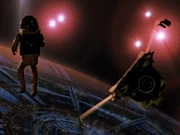
Spock detaching the thruster pack from his suit
The thruster suit was envisioned as a variation of an environmental suit, that could be equipped with a detachable thruster pack for use to travel short distances, and has been seen in use in Star Trek: The Motion Picture by, among others, Starfleet personnel at the Epsilon IX station as well as the drydock were the upgraded USS Enterprise was refurbished. Equipped with the thruster pack, Spock utilized such a suit when entering and exploring the V'Ger entity in the early 2270s, whereas James T. Kirk subsequently used a thruster suit to retrieve Spock. The design of the suit was re-utilized in Star Trek II: The Wrath of Khan. Though full-scale suits were manufactured for the actors to interact with in The Motion Picture, they themselves soldiering on in The Wrath of Khan, the construction of a miniature was deemed necessary for The Motion Picture.
Design
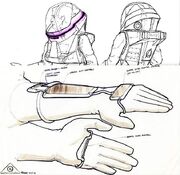
Probert's preliminary take on the EV suit

|

|
An extravehicular activity had already been envisioned in a final draft of the "In Thy Image" pilot episode of the Star Trek: Phase II television project. After Phase II was upgraded to a major movie production in November 1977, it was Paramount Pictures themselves who started with the design and partial construction of a full scale suit, which was reminiscent of the one seen in Star Trek: The Original Series. Deemed unsuitable, notoriously nearly suffocating Spock performer Leonard Nimoy, Brick Price Movie Miniatures took over the re-design work for the suit in the summer of 1978. (Enterprise Incidents; special edition on the technical side, pp. 38-42) In the autumn of 1978 the design work was handed over to Production Illustrator Andrew Probert of Astra Image Corporation, the art department subsidiary of Robert Abel & Associates (RA&A) who were to produce the visual effects for the Motion Picture, who submitted some preliminary designs for the environmental suit in October 1978. Unfortunately for him, due to the visual effects debacle, RA&A was pulled from the project on 22 February 1979. Succeeded by Douglas Trumbull's Future General Corporation, it was decided to fine tune the spacesuit design at John Dykstra's Apogee, Inc., when that company was brought in to ease the workload, since a first appearance of the suit was envisioned in a sequence Apogee was responsible for, to wit, the Epsilon IX station footage.
At Apogee, Production Illustrator Jack Johnson took over the task of designing the suit as well as that of the thruster pack that could be optionally attached to it. Details on the suit were designed by Animation and Graphics Artist Greg Wilzbach. It was their envisioned versions that were predominantly featured in The Motion Picture. Johnson was also the one who designed the thruster pack unit. (The Art of Star Trek, pp. 180-181)
Andrew Probert sold off his preliminary designs as Lot 76 in the Propworx, Inc.'s STAR TREK auction III of 24 March 2012 for US$150, having had an estimate of US$100–$200. [1]
Studio model
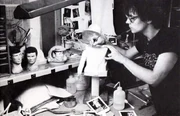
Sosalla working on the heads for the model
Apart from having full scale suits made for the actors to interact with, a scaled miniature was deemed necessary for the long shots. That miniature was also constructed at Apogee, and Dykstra has elaborated,
"Another thing we did for the Epsilon 9 sequence was build a two-foot tall scale model spaceman that we had zipping around this way and that. Doug used it also in the drydock sequence and in the Spock spacewalk. David Sosalla did the sculpting, including the faces of Spock and the others who would be inside the suit; and John Ramsay worked out the mechanics for articulating the arms and legs. It was shot using motion control, and then we went back in with animation and added little blips of energy from the thrusters. "There were a couple nice shots that didn't get into the film, where the puppets are being chased by the destruction in a different way than we've got them appearing now. But we ran out of time, and weren't able to get them to go together right." (Cinefex, issue 2, pp. 58-59)
The orange painted model about to be digitized by V'Ger
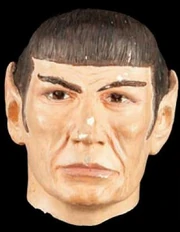
One of Sosalla's Spock head sculptures
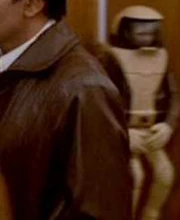
The miniature as display model
For their appearances, Sosalla sculpted several 3½ inch heads out of resin for representation of whomever was supposed to be in the suit. The models themselves were equipped with servo motors and electronics for articulation. One of Sosalla's sculptures of Spock's head later turned up at Profile in History's Hollywood Auction 43 of 18 December 2010 as Lot 1000, were it was sold, having had an estimate of US$1,000-$1,500.
Painted with orange highlights, the miniature was first used to shoot the sequences of the unfortunate Starfleet member caught in the digitizing of the Epsilon IX station and Spock's spacewalk in V'Ger. Subsequently, the highlights were repainted brown/beige for the sequences in the drydock and Kirk's EV scenes.
The miniature made an almost undiscernible re-appearance in Star Trek III: The Search for Spock as a display model in the Starfleet Officer's Lounge entry room, in the scene where Admiral Kirk and company leave.
After its use in The Search for Spock, the miniature was stored away on the Paramount Pictures lot and largely forgotten about, until Probert and Rick Sternbach rediscovered it. As the latter remembered, "If I recall correctly, when Andy was painting the head to look like himself, the rest of the suit hardshell was the orange color (early 1987?). I think we found the thing in a box in a storage room in the art department shortly after Andy and I commandeered the room over Stages 8/9. We had originally done some work in another office on the west side of the lot, but since the room over 8/9 was empty, we basically took it over. Anyhow, I’m wondering if the motor hardware was they way it was because the appendage moves had to be repeatable to within a very small tolerance, and the stepper motors I’ve seen are rather brutish to begin with. Steppers aren’t like "normal" spinning electric motors, for folks who aren’t familiar with them; the shafts are commanded to move in precise steps by motion control computers." [2](X)
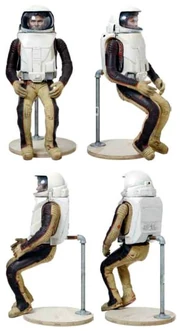
Various miniature views
Afterwards, the miniature ended up in Doug Drexler's possession for a number of years. Having had ample time to study the miniature in detail, Drexler has noted on his blog(X),
"Anyone who has watched TMP remembers the little space guy who goes ass-over-tea kettle at Epsilon 9. If you run that back you will see the puppet articulate a tad as it is hit by the Vger wave. That’s probably all the range it had. A post mortem reveals why. Most of you know that I was an effects makeup artist for ten years. In them time I built my share of puppets and change-o heads. If I had been there when this fabricated, I might have saved them a lot of grief. When you take it apart you find an impressive dual cylinder piston driven motor, which probably could have driven a mini bike. All of that horsepower was to no avail. The rubber that the suit was cast from was much too rigid for an articulated puppet. Even with all of that power behind it. I’m sure one of you guys will know the answer to this, but my guess would be that it was built by a physical effects house that may not have had a lot of puppet building experience. "All due respects to my physical effects brothers, but most of them are all about raw power. I’m guessing they were fairly certain that even though the cast was semi rigid they thought they could jam enough hp in there to make it work. I had a phys effects buddy who used to live by the adage, “don’t force it! get a bigger hammer!” By the time they found that the bigger hammer wouldn’t do it, it was too late to go back. If a makeup artist had built this rig, the appendages would have been made out of a fine cellular foam latex. if it had been me, I would have used the same foam latex we use for facial appliances. Extremly soft, malleable, great memory, and supremely paintable. If foam latex had been used you could have thrown all that expensive horsepower away. Just go to your local bicycle shop and pick up some el cheapo cables and levers, and this thing would’ve been able to dance like one of the Nicholas Brothers."
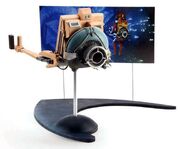
Spock's thruster pack model at auction
The pictures Drexler showcased on his blog entry revealed that some of the second paint layer had chipped off over time, revealing in some places the original orange paint layer. This may have led to Sternbach's partially erroneous recollection in regard to the color of the miniature.
Drexler eventually auctioned off his miniature, sans thruster pack, measuring 11×25 inches, as Lot 11 in the Propworx's The official STAR TREK prop and costume auction of 8 August 2010, estimated at US$8,000-$10,000, where it sold for US$8,000. According to the auction description it was the miniature that represented Admiral James T. Kirk when he retrieved Spock in the movie.
Coincidentally, Spock's thruster pack miniature, constructed out of fiberglass, metal and resin and measuring 15½ inches long, had been shortly before offered up at Profiles in History's 8-9 October 2009 Hollywood Auction 37 as Lot 611. Having been estimated at US$6,000–8,000.00, it sold for US$4,000 (exclusive buyer's premium) on 9 October 2009 to noted American collector Adam Schneider. (FanAddicts!, Season 1, Episode 3: Star Trek)

